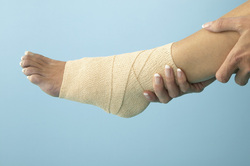Ankle Instability

1-The definition of a sprain is an injury to a joint whereas a strain is damage to a tendon or muscle. An ankle sprain is an injury to ligaments (usually to the outside of the foot or ankle). This is caused by damage to one or more ligaments. Ligaments are bands of tissue that connect bones together. They help to provide stability and alignment. If torn chance of abnormal motion or even dislocation of a joint may occur. Ligaments help to control excessive motion in all planes such as front to back, up-down, side to side, or twisting.
2-Sprains differ in severity and are graded depending on the number and percentage of ligaments damaged.
3-Causes of sprains may include: biomechanical or inherited abnormalities, ligament laxity, history of previous injury, inappropriate shoe gear/support, irregular terrain, inadequate training, trauma such as slips and falls, decreased proprioception (or position sensation), medication history (such as steroids and chemotherapeutic agents).
Signs of a sprain may include: increased motion or stiffness, pain, swelling, bruising, and difficulty walking.
4-Treatment of sprains could include: rest, ice, elevation, compression, bracing/immobilization, and crutch use.
5-Depending on the severity of the sprain professional treatment is beneficial to: repair torn ligaments, prevent weakness decreasing chances of reoccurrance, increased proprioception, strengthening of supporting muscles/tendons, addressing biomechanical faults, and ruling out other causes of ankle pain including fractures, arthritis, strains, tears, impingement syndromes etc.
2-Sprains differ in severity and are graded depending on the number and percentage of ligaments damaged.
3-Causes of sprains may include: biomechanical or inherited abnormalities, ligament laxity, history of previous injury, inappropriate shoe gear/support, irregular terrain, inadequate training, trauma such as slips and falls, decreased proprioception (or position sensation), medication history (such as steroids and chemotherapeutic agents).
Signs of a sprain may include: increased motion or stiffness, pain, swelling, bruising, and difficulty walking.
4-Treatment of sprains could include: rest, ice, elevation, compression, bracing/immobilization, and crutch use.
5-Depending on the severity of the sprain professional treatment is beneficial to: repair torn ligaments, prevent weakness decreasing chances of reoccurrance, increased proprioception, strengthening of supporting muscles/tendons, addressing biomechanical faults, and ruling out other causes of ankle pain including fractures, arthritis, strains, tears, impingement syndromes etc.